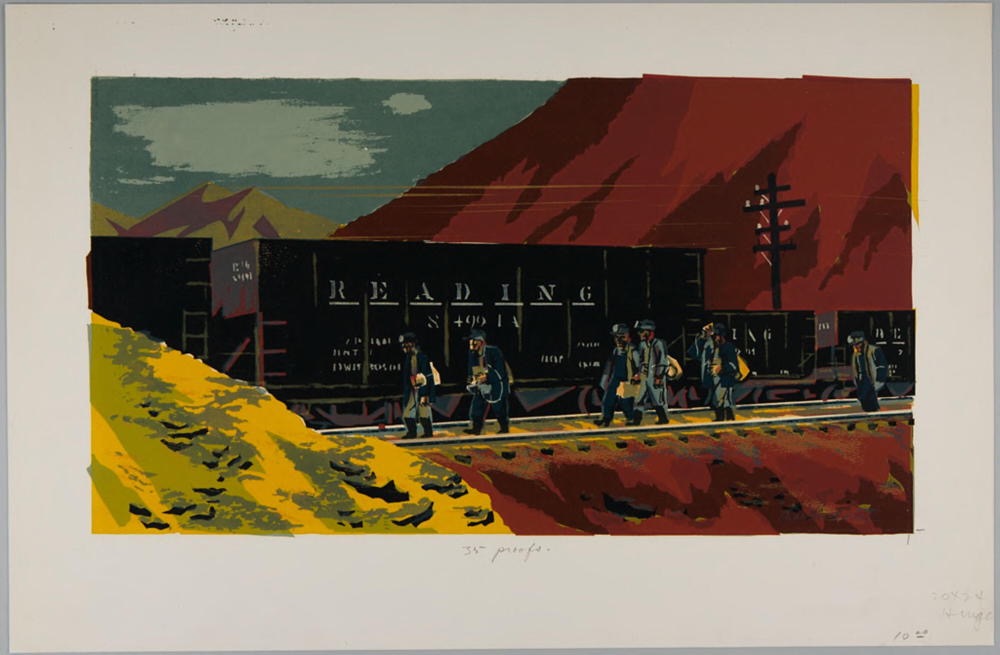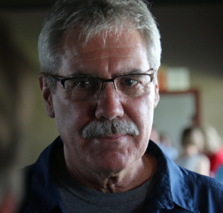ReStart

Charles Frederick Keller: Swing Shift (1940)
"I intend to watch."
Our Never-ending Porch Remodeling Project entered a new phase yesterday. In many ways, the effort was ReStart after an extended suspension, though one remote carpenter, our painter, and I had been busy over the summer, even if our chief contractor and carpenter hadn't been. The crew and I had been busy fabricating and painting porch railing pieces, which might not seem like much until you see the detailed design documents. The Muse designed these railings, which represent a melding of key elements from century-old porch railing designs she discovered while researching the history of porch railings. Her design includes passive elements to prevent water from pooling on either the top or bottom rail, as well as elements such as height, which have long fallen out of fashion, if not building codes.
The balusters required twelve separate steps to fabricate, and The Muse decided their spacing, again, based upon her extensive research into the history of baluster placement. To compensate for the railing's short height, she included two cables to be strung above the top rail, thereby satisfying building codes without overwhelming the railing profile. (Traditionally, porch railing was never higher than the bottom of the front window when viewed from the street. This produced a reliably clean and uncluttered line, which modern building codes completely undermine unless one can get clever.) The painter ultimately resorted to spray painting many of the components. This used more paint but saved so much labor that I didn't mind buying a couple more gallons of gold-plated paint. With two hundred and sixty-four balusters, hand-painting five sides might have taken forever. He screwed them upright into board bases and spray-painted them in long, uniform rows, ten or fifteen at a time.
I'd painted post covers and crown moulding trim by hand in what turned out to be the wrong paint, once the painter came on board. He proposed using a satin finish to prevent dust from discoloring the finish, and this made sense to me, even though the change meant having to repaint some of what I'd already finished. When constructing for the ages, one avoids cutting corners. We painted each piece of the railing with at least four coats of paint. The first coat is a preservative, followed by an oil-based primer, and then two coats of the satin-finish top color. As the railings are actually installed between the newly poured concrete pillars completed a year ago in an earlier phase of this seemingly never-ending effort, the installer applies a quick coat of the preservative on all the cut ends. The railing components were cut to measure to fit between the pillars and posts, with at least an inch of extra length to allow for precise fitting when installed.
Marco, the master carpenter, arrived early yesterday morning. I saw him pull up nearly an hour before Jesse, the contractor, said he'd arrive. They surveyed the space, seeking to determine where to begin their labors. They decided four times, with better ideas occurring to them in easy succession, before deciding to fabricate the two front railings first, as they spanned fixed space between concrete pillars. Other railings bridge between a pillar and a post, a pillar and a wall, or a post and another post, and those involve more variability when installing. A rigid context seemed best to pilot the first railing installations. Marco worked for about four hours, fitting the bottom rails and carefully measuring their balusters. He was not nearly finished before the sun chased him off the job that afternoon. Jesse had taken most of the painted elements back to his shop, where Steve, another master carpenter, will assemble railing sets with access to more precision tools than might be set up on the crude sideyard table here. Posts and beams, installed after the concrete foundation and pillars were poured, will still need to be clad and painted.
Once Kurt the painter and I had finished painting the components, I felt like we might be close to finishing the project, but cladding those posts and beams should keep the driveway pop-up paint shop in business through the month. This means that I can look forward to dressing in my overalls most every morning between now and autumn. I would rather be engaged and close to the action. This result should easily last through the upcoming century. I confided to Jesse that I expected it to last through at least my next reincarnation and that I would be watching. I intend to watch.
©2025 by David A. Schmaltz - all rights reserved


